Looking for a low tech way to add some life and color to your aquarium? Carpet plants are an ideal choice! These plants can provide cover and hiding spots for fish, as well as add beauty to any tank. Here’s our list of 15 low tech carpet plants you should consider adding to your aquarium.
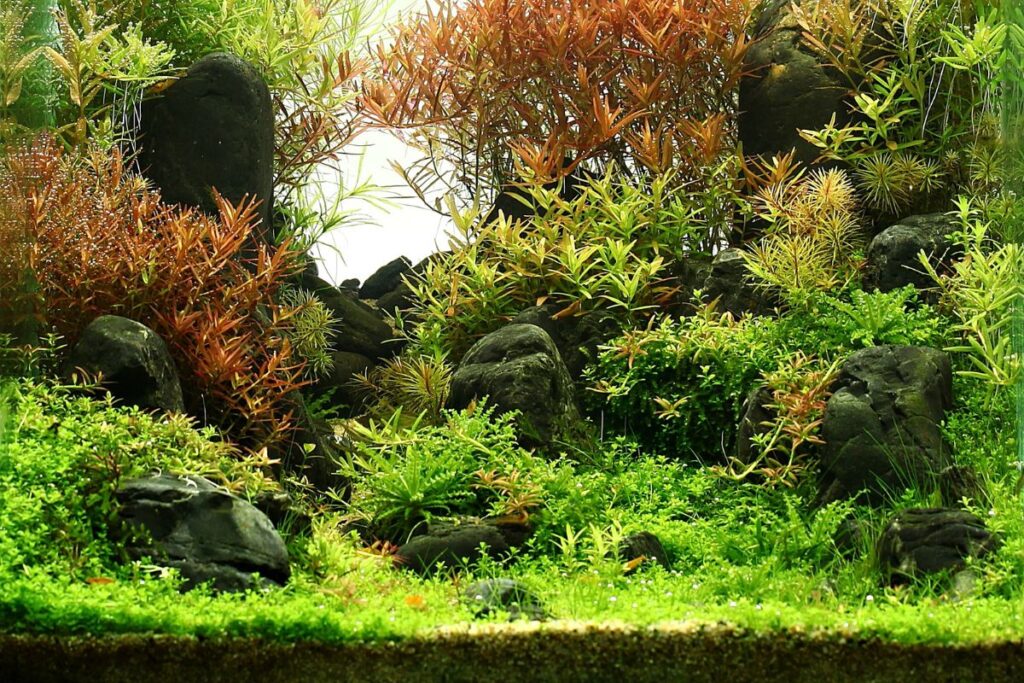
Contents
- 1 15 Low Tech Carpet Plants For Aquariums
- 1.1 Dwarf Sagittaria (Sagittaria Subulata)
- 1.2 Rio Cristalino (Staurogyne Repens)
- 1.3 Java Moss (Vesicularia Dubyana)
- 1.4 Pygmy Chain Swords
- 1.5 Helanthium Tenellum
- 1.6 Dwarf Hairgrass (Eleocharis Parvula)
- 1.7 Micro Sword (Lilaeopsis Brasiliensis)
- 1.8 Pellia Epiphylla
- 1.9 Christmas Moss (Vesicularia Montagnei)
- 1.10 Dwarf Baby Tears (Hemianthus Callitrichoides)
- 1.11 Monte Carlo (Micranthemum Tweediei)
- 1.12 Glosso (Glossostigma Elatinoides)
- 1.13 Four Leaf Clover (Marsilea Hirsuta)
- 1.14 Hydrocotyle Japan (Hydrocotyle Tripartita)
- 1.15 Pearl Weed (Hemianthus Micranthemoides)
- 2 Conclusion
15 Low Tech Carpet Plants For Aquariums
Carpet plants are incredibly versatile; they come in a wide range of colors and textures, allowing you the freedom to create whatever look you desire. Plus, most don’t require high levels of light or special care – making them easy enough even for novice aquarists. Whether you’re looking for something fast-growing or slow-growing, these 15 options offer plenty of choices.
Dwarf Sagittaria (Sagittaria Subulata)
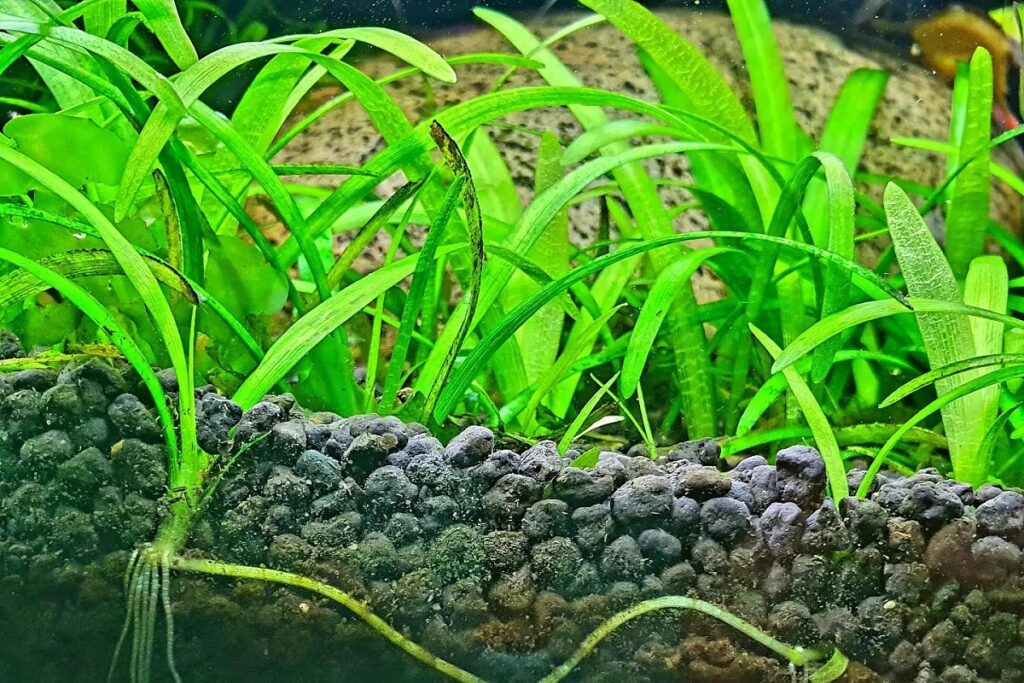
Dwarf Sagittaria, also known as Saggitaria subulata is a popular low-tech carpet plant for aquariums. This hardy aquatic species can bring beauty and life to any tank without high maintenance requirements. When choosing this plant for your aquarium, it’s important to consider planting techniques, light requirements, substrate preferences, water parameters, and feeding habits.
The Dwarf Sagittaria prefers moderate lighting in order to thrive. Moderate lighting will help the plants establish fully and keep them healthy when planted in an appropriate substrate such as sand or gravel. Once established in the tank, these plants are undemanding of specific water parameters but should be kept away from intense filtration systems that may disturb their delicate roots.
To ensure optimal growth for your Dwarf Sagittaria you’ll need to provide regular fertilization throughout the year. Feeding these beautiful carpet plants with liquid carbon supplements on a weekly basis will allow them to grow lush and vibrant underwater lawns over time.
Rio Cristalino (Staurogyne Repens)
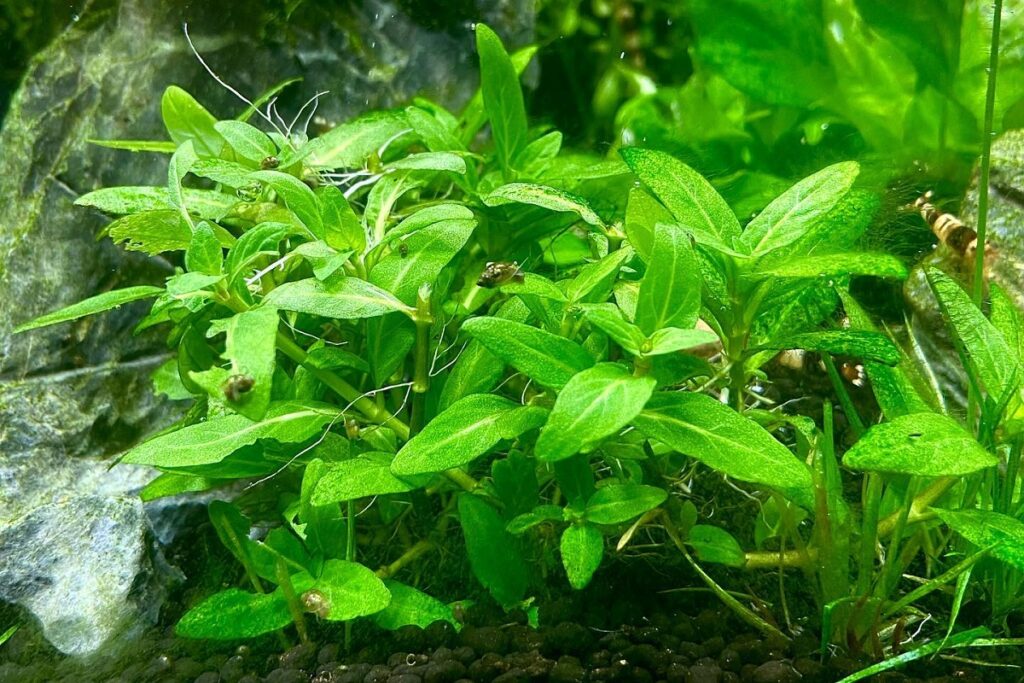
Rio Cristalino, or Staurogyne repens, is a popular low-tech carpet plant for aquariums. Caring for it is easy and its growth rate is quite fast – perfect for aquarists who are starting out their journey with aquatic plants! Lighting requirements of Rio Cristalino range from moderate to high and fertilizing needs should be met regularly. Propagation tips include propagating through stem cuttings: simply clipping the stem where you’d like new sprouts to appear and replanting them in your substrate.
When caring for Rio Cristalino, make sure not to disturb the roots too much as this can damage the plant. You also want to ensure that there’s enough light available so that photosynthesis occurs properly, otherwise, the leaves may turn yellow and become stunted. Fertilizers will help promote healthy growth but do check labels to see which ones are compatible with your setup.
Java Moss (Vesicularia Dubyana)
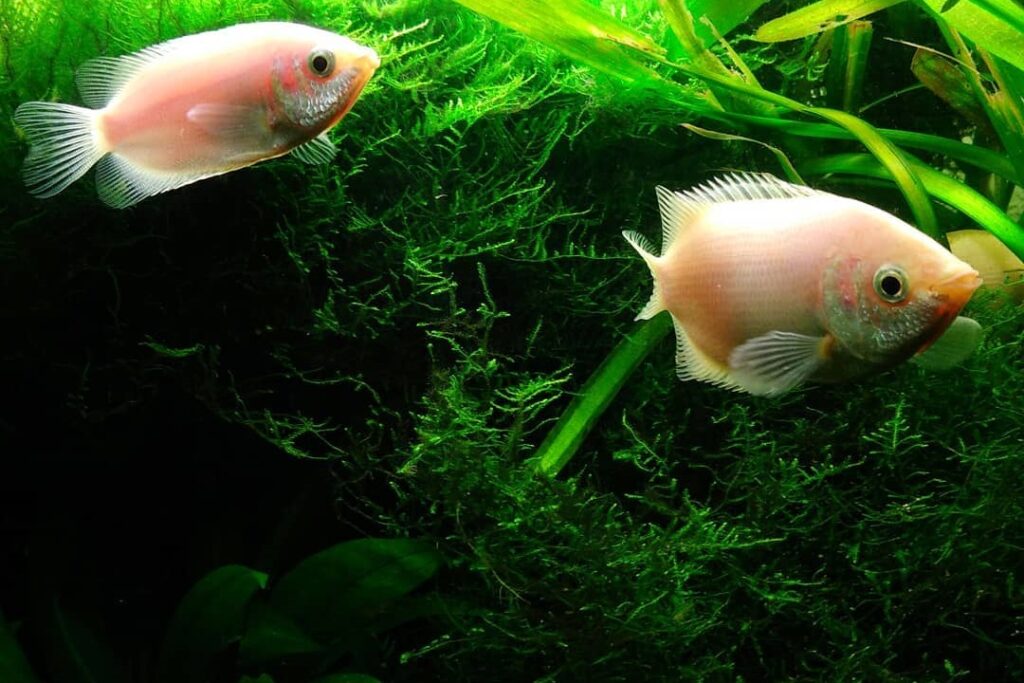
Having discussed Rio Cristalino, let us now move on to Java Moss. Java moss is a great choice of carpet plant for aquariums because it has many benefits and requires minimal care. It can be grown in almost any condition and provides an interesting texture to the tank that other plants cannot replicate. Here we will discuss its growth, lighting requirements, care tips, and propagation methods.
One of the main advantages of this versatile species is its hardiness – it stands up well against algae or pollutants in the water which may harm other plants. Additionally, due to its small size and low light requirements, java moss grows quickly so you don’t have to wait long before seeing results. Its aesthetics also make it perfect for aquascaping as it adds an interesting element to tanks with more traditional foliage plants such as Anubias Nana or Cryptocoryne Wendtii Red.
To encourage healthy growth, you should use fertilizers once a week but avoid adding too much since java moss does not require high levels of nutrients like some other aquatic plants do. You should also monitor your water parameters regularly; pH levels between 6-7 are ideal while temperatures should range from 68-75°F (20–24°C). When planting java moss, ensure that there’s enough space between each piece so they don’t get tangled together over time.
This species thrives best under low light but can still survive in brighter setups if need be – just keep an eye out for algae growth! If you’re looking to propagate your existing java moss, simply take a few clumps off from the bottom of the original plant and tie them onto driftwood pieces or rocks using string or thread until new roots form around the substrate material after a couple of weeks’ time.
Pygmy Chain Swords
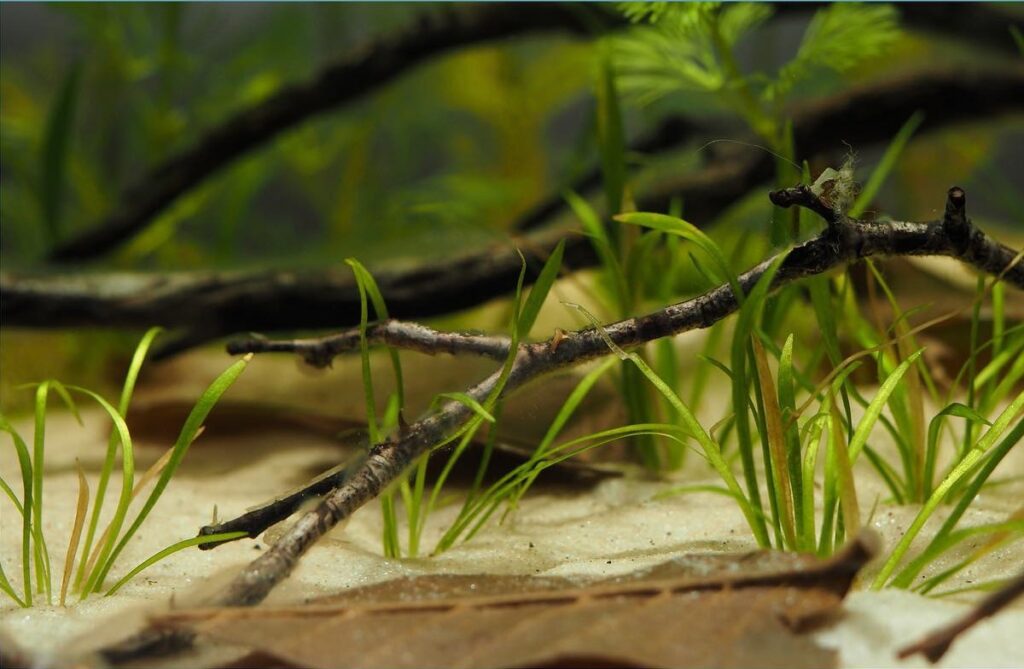
Pygmy Chain Swords are a low-tech carpet plant for aquariums. They can be propagated easily, with their runners quickly spreading around the tank to create an attractive display of foliage. The care required is minimal; they do best in medium light and require regular fertilization to remain healthy and lush.
When it comes to types of pygmy chain swords, there are several species available that vary slightly in size and coloration. All will thrive under similar conditions, so no matter which one you choose for your tank, the requirements for keeping them happy are straightforward.
These plants offer many benefits; from creating natural-looking habitats for fish to providing oxygen for beneficial bacteria growth. Pygmy chain swords also help control algae levels by competing for nutrients with other aquatic life forms in the tank. With proper care, these carpets make stunning additions to any aquascape!
Helanthium Tenellum
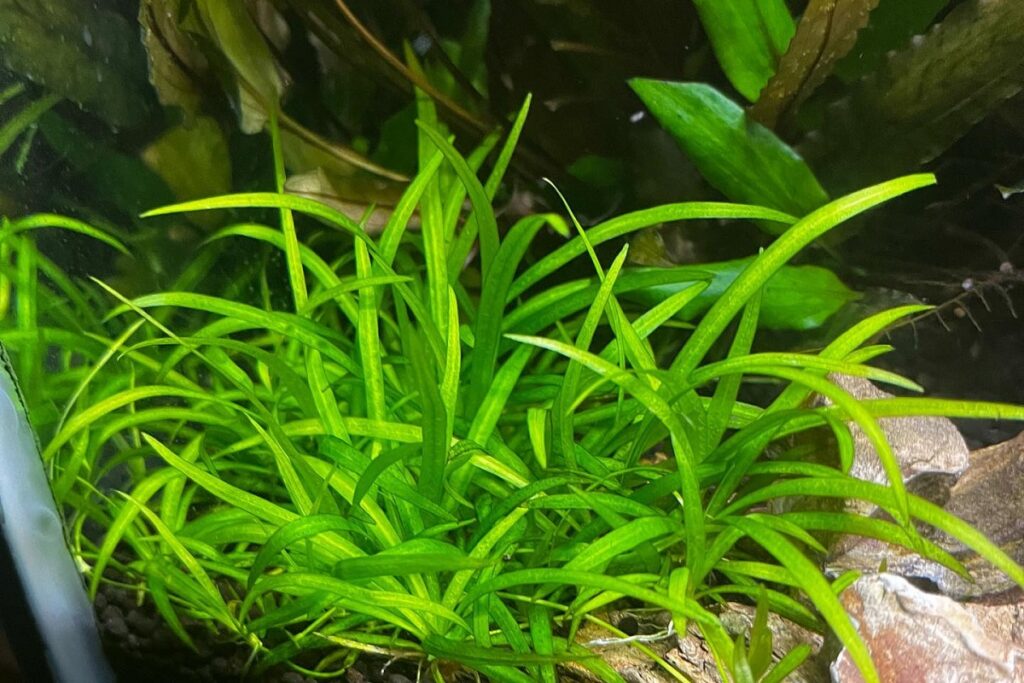
Pygmy Chain Swords, though a great addition to an aquarium, may be too large for some aquascapes. Fortunately, Helanthium Tenellum is a smaller alternative that can bring the same beauty and charm as Pygmy Chain Swords in a more compact form.
Helanthium Tenellum’s Growth is quite fast compared to other dwarf carpet plants, with new shoots emerging every few days if cared for properly. Care Requirements are relatively straightforward; moderate lighting paired with the nutrient-rich substrate will ensure this plant thrives in your tank.
Propagation can easily be achieved by trimming off the top of the stems and replanting it elsewhere in the aquarium – simply provide enough light and nutrients to encourage growth and you’ll have yourself another beautiful patch of grass!
Adaptability makes this species ideal for all sorts of different tanks as well– from coldwater setups like goldfish tanks to tropical ones full of vibrant colors. Its Aquascaping Potential also adds to its value – almost any design you could imagine would be complemented nicely by these miniaturized chain swords.
Dwarf Hairgrass (Eleocharis Parvula)
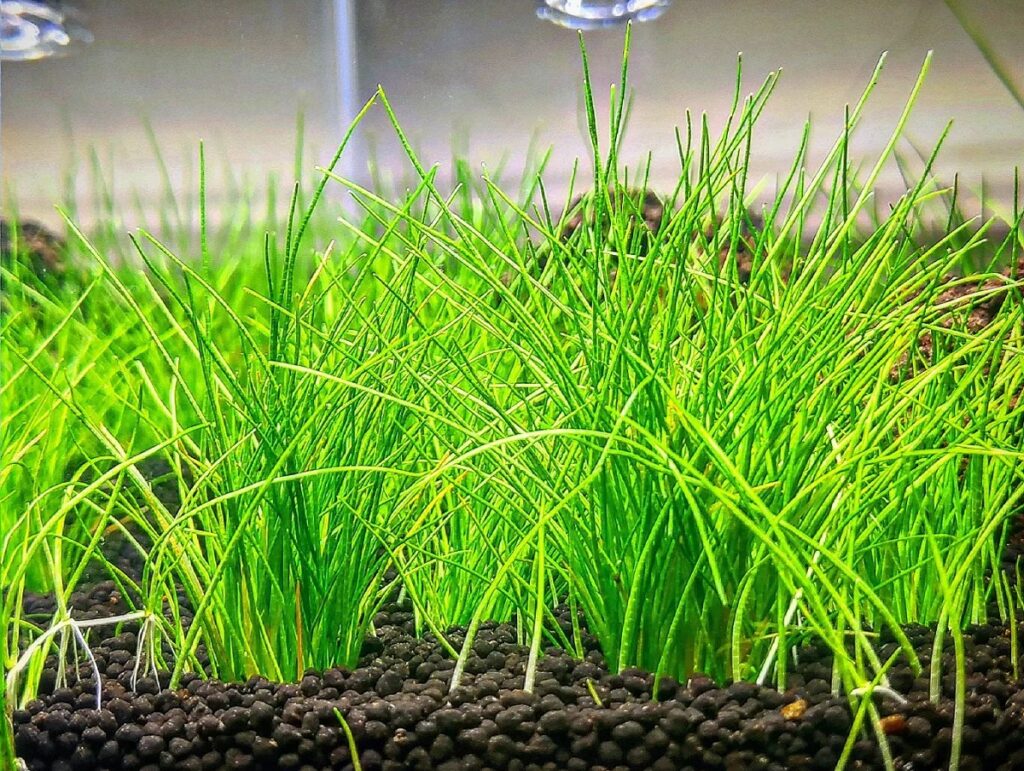
The beauty of the Dwarf Hairgrass, or Eleocharis parvula, is that it can instantly transform any aquarium into a lush oasis. With its low maintenance requirements and easy propagation techniques, this carpet plant will bring life to your tank in no time.
When planting the grass-like shoots, make sure you give them enough room to spread out. Although lighting requirements are minimal for these plants, they still need adequate light to carry out photosynthesis and take up nutrients from the substrate below. When looking at nutrient uptake, be mindful of maintaining a soil pH balance as too much acidity could affect the health of your plants.
Propagation tips include removing runners during water changes; simply use some tweezers to separate them into individual pieces before replanting them around the base of existing clumps. Remember to keep an eye on their growth rate so that all areas get evenly covered with foliage!
Micro Sword (Lilaeopsis Brasiliensis)
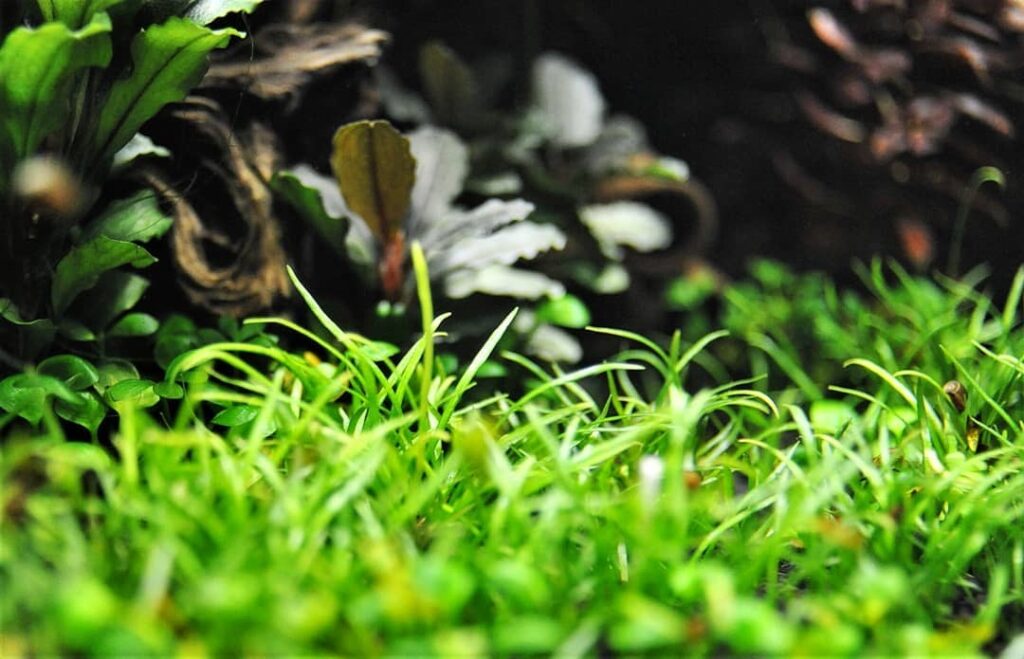
Micro Sword (Lilaeopsis brasiliensis) is an ideal low tech carpet plant for aquariums. It has a wide range of propagation techniques, making it easy to grow in any tank setup. Lighting requirements for this species are relatively low; however, the substrate and nutrient considerations should be taken into account when setting up your aquascape.
When choosing a substrate for Micro Sword, look for one that will provide adequate nutrients while still allowing good water flow. The best substrates would generally consist of sand or gravel with some added fertilizer pellets or laterite clay. Good lighting is also important as it helps promote healthy growth and thick foliage cover, so select bulbs and fixtures accordingly.
Filtration requirements depend on the size of your tank, but any filter providing a steady current at a moderate speed should suffice. Proper filtration helps keep the water clean and clear, which encourages strong root systems and lush green leaves. Keeping these factors in mind can ensure you have beautiful carpets of Micro Sword in no time!
Pellia Epiphylla
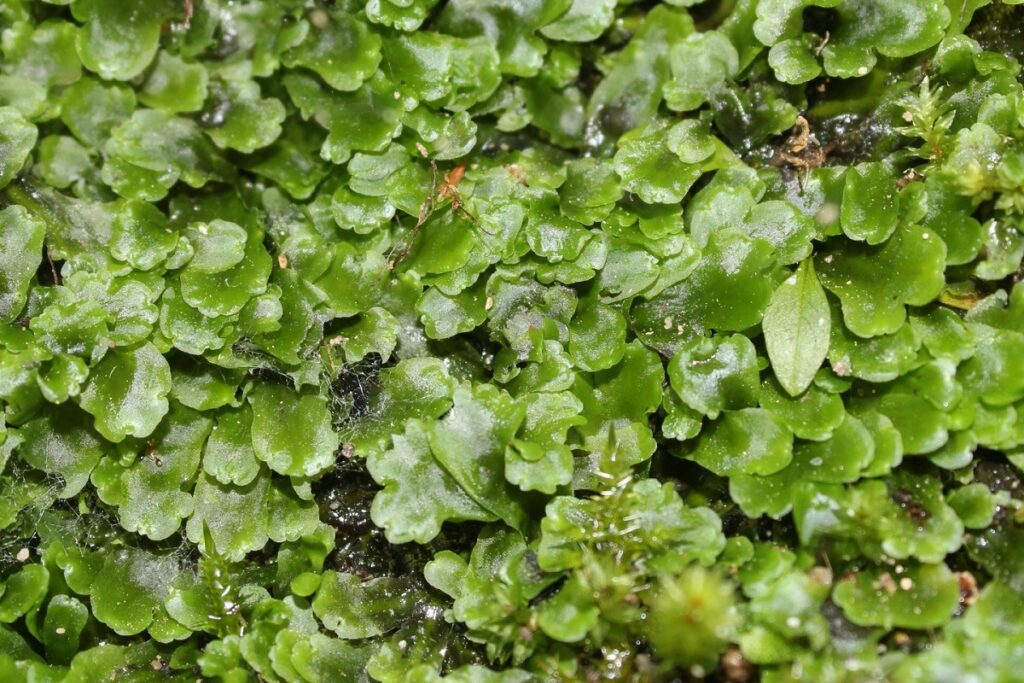
Moving on from Micro Sword, Pellia epiphylla is a great low tech carpet plant for aquariums. They are easy to care for and provide an interesting texture to the tank’s bottom layer. This liverwort species can survive in both colder and warmer water temperatures with its light requirements ranging between medium-high intensity lighting. It also helps to filter out nitrates through its nutrient supply and doesn’t require any fertilization needs either.
Pellia epiphylla is one of the only plants that don’t need CO2 as they absorb carbon dioxide directly from the atmosphere instead. As long as it has enough nutrients, these plants will thrive without needing much special attention or maintenance! Not only do they create a lush foreground in your aquarium but their root system works wonders at keeping debris off the ground too.
The best part about having these aquatic mosses around? They actually help keep your fish healthy by providing them with shelter when necessary and hiding spots during feeding times! Plus, given how hardy Pellia epiphyllas are, you won’t have to worry about regularly replacing them like other more fragile aquarium plants – making them ideal for busy aquarists who want something straightforward yet effective.
Christmas Moss (Vesicularia Montagnei)
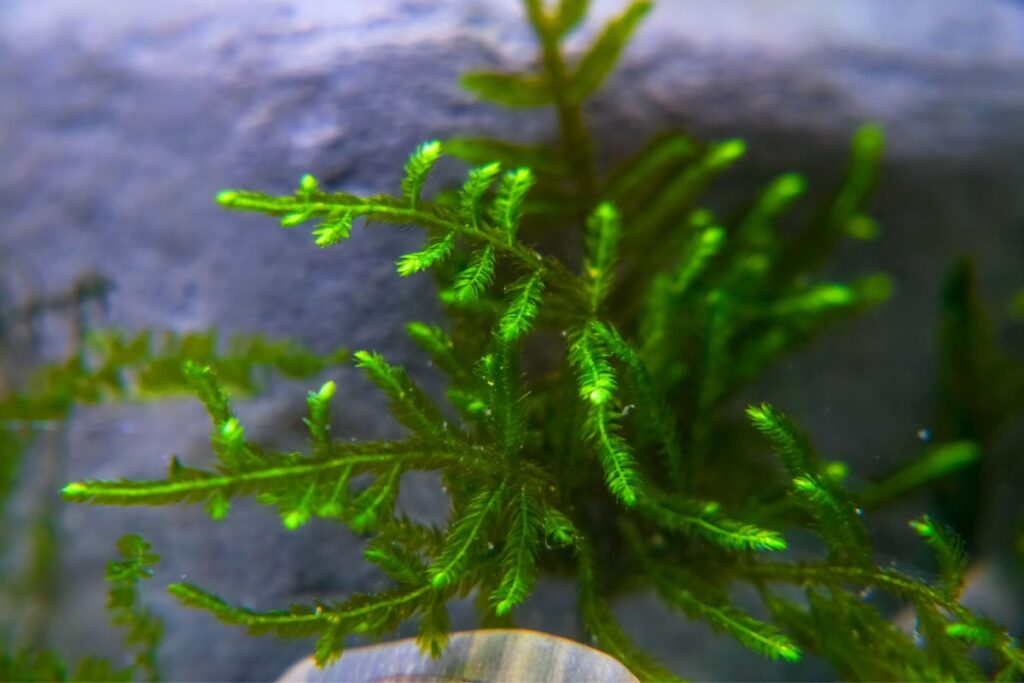
Christmas Moss (Vesicularia Montagnei) has become increasingly popular among novice and veteran aquarists alike in recent years due to the ease of maintenance and the aesthetic benefits it provides. This species is an ideal low-tech carpet plant for any aquarium, as long as certain requirements are met. Maintaining Christmas moss requires a medium range of lighting, moderate water flow, and regular pruning; thankfully these conditions are easily achievable with most home aquariums.
The benefits of using this aquatic species to cover substrates or create vertical walls far outweigh any minor constraints posed by keeping them alive. Christmas Moss can reduce nitrate levels while providing natural shade and hiding spots throughout your tank. Not only that but they also act as a living filter when propagated on driftwood or rocks, removing toxins from the water before they reach other sensitive inhabitants. In addition, their unique leaf structure gives even small tanks an interesting dimension – something which many traditional plants do not offer.
Dwarf Baby Tears (Hemianthus Callitrichoides)
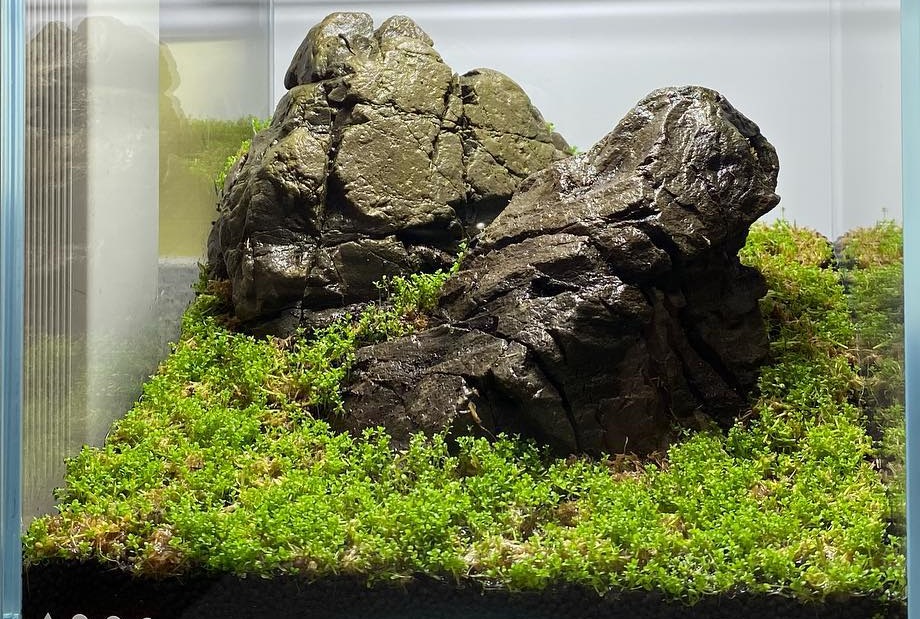
The Dwarf Baby Tears, commonly known as Hemianthus callitrichoides, is a low-tech carpet plant that will make any aquarium look stunning. With the right propagation techniques and growth requirements in mind, this species can quickly transform your tank into an aquascape of beauty. When paired with the correct lighting needs, it’s easy to achieve lush coverage over large areas within days.
As far as tips for aquascaping are concerned, careful pruning of stems will help maintain a dense lawn appearance. However, when propagating new plants from cuttings, avoid trimming too much at once or you’ll risk damaging the existing ones. To ensure strong growth and healthy foliage coloration, fertilization advice should also be considered; aim to use liquid fertilizers rich in iron and macronutrients every week or two during peak growing season (i.e., spring).
This gorgeous aquatic species is sure to brighten up any home aquarium making it appear professionally designed without hours spent scaping. Whether used as foreground accent pieces or background fillers – or both! – Dwarf Baby Tears are guaranteed to bring life and vibrancy into your underwater world.
Monte Carlo (Micranthemum Tweediei)
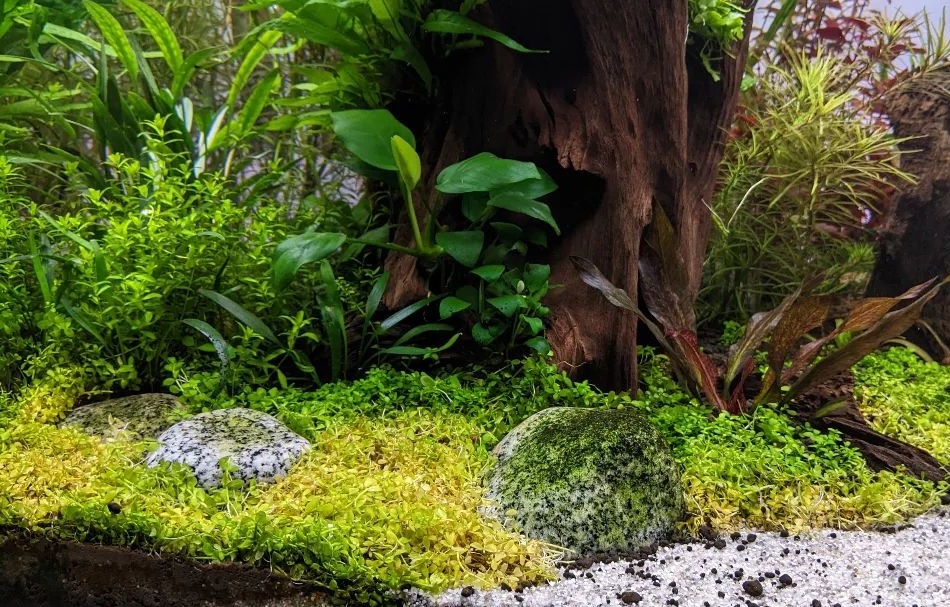
Leaving the lush greenery of Dwarf Baby Tears behind, we come now to Monte Carlo. This hardy little stem plant is a great choice for any aquarium setup and can bring a vibrant touch of green to your underwater paradise. With its delicate leaves and bright colors, it’s sure to make an eye-catching addition!
When caring for this species, you’ll want to ensure that lighting levels are moderate to high with at least 12 hours per day in order to keep them healthy and happy. The water should also be kept slightly acidic — around 6.5 pH — with regular partial water changes every two weeks or so. Propagation is fairly straightforward too; simply cut off sections of the stems above a node (where new leaves emerge) and replant them into the substrate or leave them floating until they take root.
If you’re looking for benefits from having Monte Carlo in your tank then look no further than more oxygen production thanks to its additional photosynthesis as well as some extra filtration power through absorbing nitrates directly from the water column. Trimming isn’t necessary when keeping this species, though pruning may help if it becomes out of control by preventing it from taking over other plants’ space.
Glosso (Glossostigma Elatinoides)
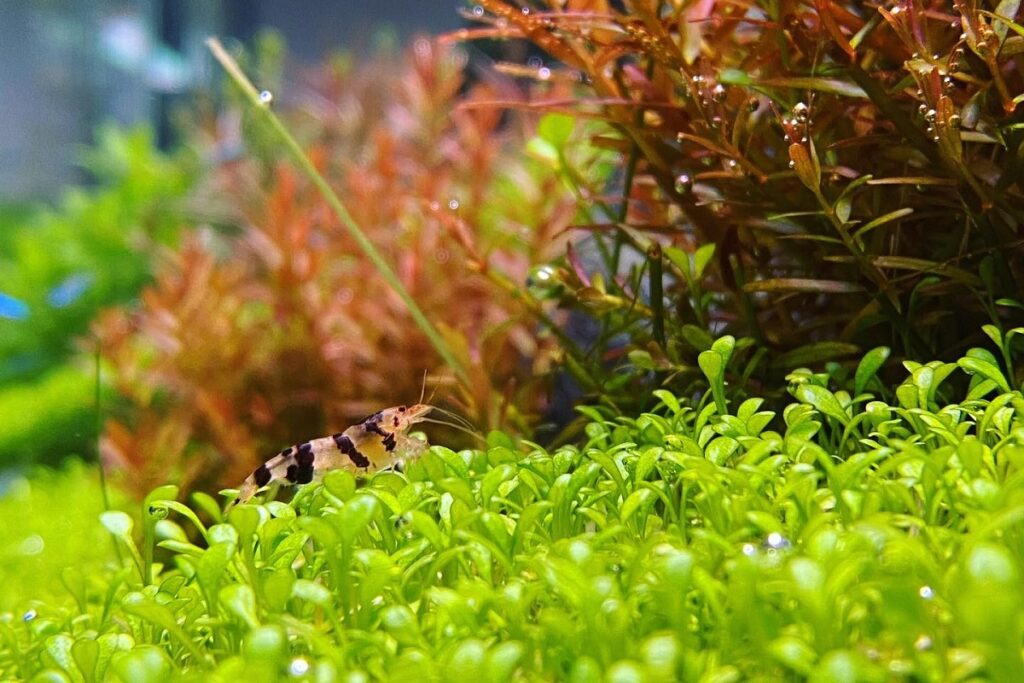
Glosso is a beautiful low tech carpet plant for aquariums. Its vibrant green color, delicate leaves and low growing profile make it an ideal choice to create a lush foreground in your tank. It may be small in size but its potential impact on the overall look of your setup is immense! When properly cared for, Glosso can bring life and energy to any aquatic environment.
When considering this species as part of your planted aquarium, you’ll want to pay close attention to its nutrient requirements. Glosso prefers softer water with high levels of nitrate and phosphate rather than soft acidic water with minimal nutrients – so be sure to test the quality before introducing it into your tank. Additionally, Glosso benefits from regular dosing of liquid fertilizers that contain iron and other trace minerals such as potassium or magnesium.
As far as growth habits are concerned, proficient aquarists have found that Glosso grows best when kept at temperatures between 18-26°C (64-79°F). Furthermore, proper lighting is essential for optimal growth; providing 8-10 hours per day of medium light intensity helps ensure vigorous growth while also keeping algae away from the leaves.
Four Leaf Clover (Marsilea Hirsuta)

Continuing on from the discussion of Glosso, we now turn to the equally popular aquarium plant: Four Leaf Clover. This is a unique species that provides many nutritional benefits in addition to its aesthetic appeal. With its bright green color and rounded leaves, it’s sure to be a standout amongst other plants in your tank.
Four Leaf Clover grows at an impressively fast rate – usually around 2-3 cm per month! It also propagates easily through runners, making it simple to grow this lovely aquatic carpeting for your aquarium. To ensure optimal growth, however, you should make sure that your tank has plenty of light available with CO2 levels kept slightly high. The ideal nutrient balance when cultivating this plant should have a pH level between 6-7 and hardness between 4-8 dGH.
Aside from lighting, temperature conditions are important too; ideally ranging between 18-28°C (64-82°F). Fortunately, these requirements make this particular species suitable for most freshwater tanks which makes it an excellent choice if you’re looking to add some greenery to your space without much hassle or fuss.
Hydrocotyle Japan (Hydrocotyle Tripartita)
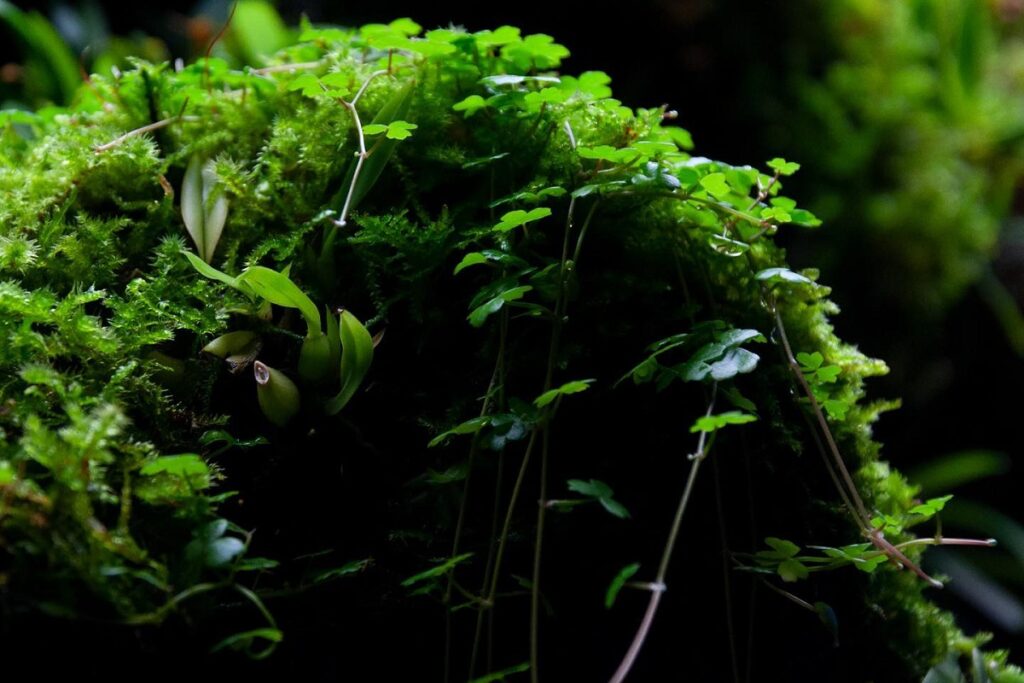
Hydrocotyle Japan, also known as Hydrocotyle tripartita, is an excellent low-tech carpet plant for aquariums. This hardy and versatile aquatic species requires minimal maintenance and provides numerous benefits to the tank’s inhabitants. Nutrient requirements are easily met by adding fish waste, decomposing organic matter, liquid fertilizers, or even compost tea to the environment.
Lighting considerations should take into account the intensity of light needed for optimal growth: too much exposure can lead to excessive algae formation. In terms of growth habits, this species grows quickly and spreads rapidly when given ideal conditions. As far as care tips go, it’s important to trim older leaves regularly so new shoots will emerge from the bases; pruning helps maintain a neat appearance while providing more oxygenation within the tank.
Pearl Weed (Hemianthus Micranthemoides)
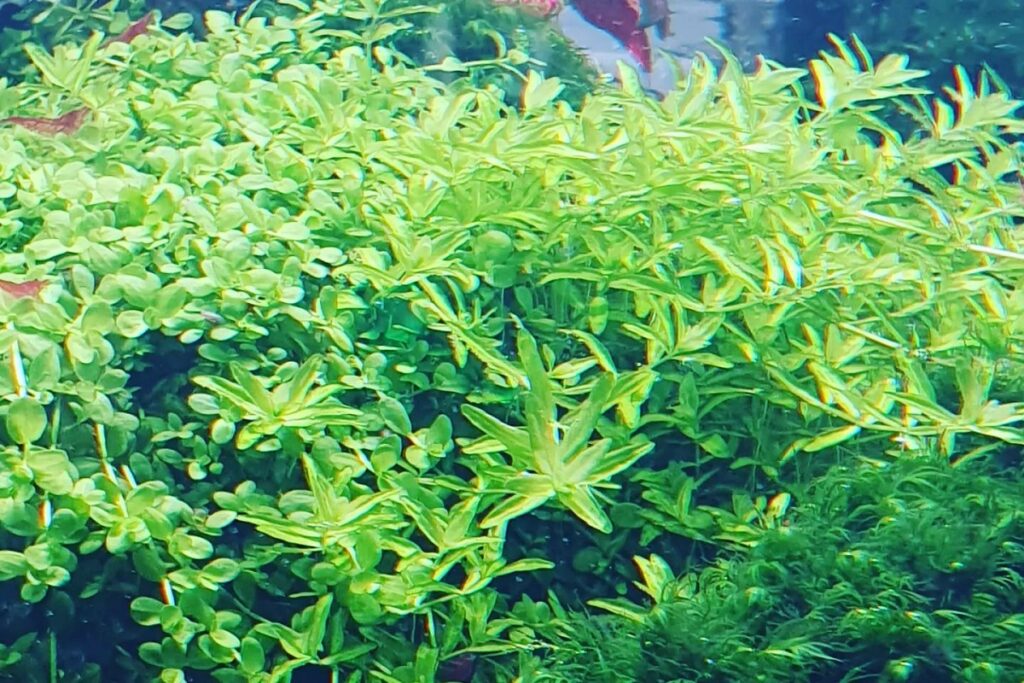
Moving on from Hydrocotyle Japan, Pearl Weed is another popular low-tech carpet plant for aquariums. This species of aquatic plant prefers moderate to high lighting but can adapt to lower light situations. It’s important to maintain water parameters that are slightly acidic with a pH between 6 and 7.5. Nutrient needs should be met through regular dosing of liquid fertilizer or by adding root tabs when planting it on the substrate.
When it comes to planting methods, this fast-growing stem plant works best as a carpeting foreground species when anchored down with mesh netting or thread. If you choose the latter option, make sure to keep an eye out for any new shoots so they can be secured properly; if left unsecured, these stems will quickly grow upwards instead of horizontally across the tank floor! Pruning techniques should also be employed regularly to achieve optimal results – simply use scissors or tweezers to clip away at the taller stems and replant them elsewhere in the tank for fuller coverage.
Conclusion
In conclusion, these 15 low-tech carpet plants are great for aquariums. They add vibrant color to your tank and help create a healthy environment for fish and other aquatic life. I recommend that any aquarist looking for an easy-to-care-for plant look into Dwarf Sagittaria, Rio Cristalino, Java Moss, Pygmy Chain Swords, Helanthium tenellum, Glosso, Four Leaf Clover, or Hydrocotyle Japan. These will all do well in most tanks with minimal maintenance required. Pearl Weed is also a great choice if you want something more eye-catching. With the right care and attention, these plants can bring new life to your aquarium!
